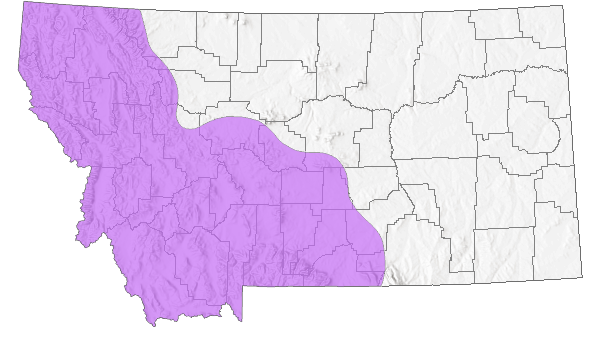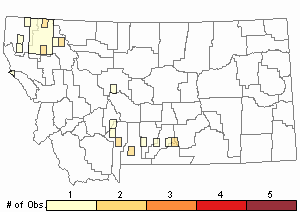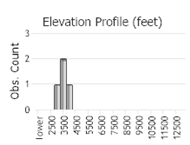View in other NatureServe Network Field Guides
NatureServe
Montana
Utah
Wyoming
Idaho
Wisconsin
British Columbia
South Carolina
Yukon
California
New York
Alberta Snowfly - Isocapnia integra
State Rank Reason (see State Rank above)
The Alberta snowfly is currently ranked "S2" in Montana because it was thought to be at risk due to very limited and/or potentially declining population numbers, range and/or habitat, making it vulnerable to extirpation in the state. But, recent range extensions due to taxonomic changes may warrant re-evaluating this SOC rank.
- Details on Status Ranking and Review
Alberta Snowfly (Isocapnia integra) Conservation Status Review
Review Date = 09/18/2008
Population Size
ScoreU - Unknown
CommentUnknown.
Range Extent
ScoreU - Unknown
Area of Occupancy
CommentLB = 4-40 km (about 2.5-25 miles)
Length of Occupancy
ScoreLB - 4-40 km (about 2.5-25 miles)
Long-term Trend
ScoreE - Relatively Stable (±25% change)
Short-term Trend
ScoreE - Stable. Population, range, area occupied, and/or number or condition of occurrences unchanged or remaining within ±10% fluctuation
Threats
ScoreF - Widespread, low-severity threat. Threat is of low severity but affects (or would affect) most or a significant portion of the population or area.
SeverityLow - Low but nontrivial reduction of species population or reversible degradation or reduction of habitat in area affected, with recovery expected in 10-50 years.
ScopeModerate - 20-60% of total population or area affected
ImmediacyLow - Threat is likely to be operational within 5-20 years.
Intrinsic Vulnerability
ScoreB - Moderately Vulnerable. Species exhibits moderate age of maturity, frequency of reproduction, and/or fecundity such that populations generally tend to recover from decreases in abundance over a period of several years (on the order of 5-20 years or 2-5 generations); or species has moderate dispersal capability such that extirpated populations generally become reestablished through natural recolonization (unaided by humans).
Environmental Specificity
ScoreA - Very Narrow. Specialist. Specific habitat(s), substrate(s), food type(s), hosts, breeding/nonbreeding microhabitats, or other abiotic and/or biotic factor(s) are used or required by the Element in the area of interest, with these habitat(s) and/or other requirements furthermore being scarce within the generalized range of the species within the area of interest, and, the population (or the number of breeding attempts) expected to decline significantly if any of these key requirements become unavailable.
General Description
Species within the Capniidae are small winter stoneflies. This family is one of the largest families in the order Plecoptera, containing some 300 species distributed throughout the Holarctic region, 25 species occur in Montana. As their name implies these species are generally cold-water stenotherms and hatch in late-winter through early spring. The adults emerging in the winter are often found walking around on the snow. Their closest relatives are the Rolled-winged Stoneflies (Leuctridae). Many species are endemic to small ranges, perhaps due to the family's tendency to evolve tolerance for cold (isolating populations in mountain valleys) and winglessness (inhibiting dispersal).
Phenology
Adults are usually flying from late-April to May and into June.
Diagnostic Characteristics
Larvae cannot be identified to species and adults are rarely collected by summer sampling. Isocapnia fraseri and I. missourii are synonymized with I. integra (Zenger and Baumann 2004). Isocapnia missourii (taxon) has been removed from the central database and collection records are now displayed as I. intregra.
Species Range
Montana Range
Range Descriptions

 Native
Native
Range Comments
Rangewide, the species is found from the northern Rocky Mountains (extends north to the northeastern coast of Alaska, west into Alberta), and east to western South Dakota. While it once seemed restricted to the North Fork Flathead (MT) and Banff National Park, with the taxonomic revision to include Isocapnia missourii, it has expanded is range in Montana to the SW part of the state and the east side of the continental divide and over to the Black Hills of western SD.
Observations in Montana Natural Heritage Program Database
Number of Observations: 25
(Click on the following maps and charts to see full sized version)
Map Help and Descriptions
Relative Density

Recency



 (Observations spanning multiple months or years are excluded from time charts)
(Observations spanning multiple months or years are excluded from time charts)
Migration
This species is not known to migrate and in fact, the males are sometimes "apterous" or "micropterous" and cannot fly.
Habitat
Very little information exists about the ecology of this species (Baumann et al. 1977). Collections have found this species in small streams and large rivers. Early records reported members of this species to be found in Banff National Park and North Fork Flathead River which are coldwater systems, but additional records have found them in transitional cold-cool water systems (Smith River, Missouri river). These stoneflies are trophically shredder-detritivores.
Food Habits
Merritt and Cummins (1996) report that members of this family are trophically shredder-detritivores; eating large particulate organic materials such as detritus, leaves and plants.
Ecology
These stoneflies are probably cold water stenotherms.
Reproductive Characteristics
Adults are typically flying in May and June.
Management
No management plan is in place, but more targeted sampling in early spring is recommended to fully understand this species' distribution, as it may be more widespread than previously thought.
Threats or Limiting Factors
Listed as a rare species when found, never abundant. Larvae cannot be identified to species and adults are rarely collected by biomonitoring agencies, thus few records exist.
References
- Literature Cited AboveLegend:
 View Online Publication
View Online Publication Baumann, R.W, A.R. Gaufin, and R.F. Surdick. 1977. The stoneflies (Plecoptera) of the Rocky Mountains. American Entomological Society, Philadelphia.
Baumann, R.W, A.R. Gaufin, and R.F. Surdick. 1977. The stoneflies (Plecoptera) of the Rocky Mountains. American Entomological Society, Philadelphia. Merritt, R.W. and K.W. Cummins. 1996. An introduction to the aquatic insects of North America. 3rd Edition. Kendall/Hunt Publishing Company. Dubuque, Iowa. 862 pp.
Merritt, R.W. and K.W. Cummins. 1996. An introduction to the aquatic insects of North America. 3rd Edition. Kendall/Hunt Publishing Company. Dubuque, Iowa. 862 pp. Zenger, J.T. and R.W. Baumann. 2004. The Holarctic winter stonefly genus Isocapnia, with an emphasis on the North American fauna (Plecoptera: Capniidae). Monographs of the Western North American Naturalist 2(1):65-95.
Zenger, J.T. and R.W. Baumann. 2004. The Holarctic winter stonefly genus Isocapnia, with an emphasis on the North American fauna (Plecoptera: Capniidae). Monographs of the Western North American Naturalist 2(1):65-95.
- Additional ReferencesLegend:
 View Online Publication
View Online Publication
Do you know of a citation we're missing? Gustafson, D. L. 1990. Ecology of aquatic insects in the Gallatin River drainage. Ph.D. Dissertation. Bozeman, MT: Montana State University. 194 p.
Gustafson, D. L. 1990. Ecology of aquatic insects in the Gallatin River drainage. Ph.D. Dissertation. Bozeman, MT: Montana State University. 194 p. Stadnyk, L. 1971. Factors affecting the distribution of Stoneflies in the Yellowstone River, Montana. M.Sc. Thesis. Bozeman, Montana: Montana State University. 36 p.
Stadnyk, L. 1971. Factors affecting the distribution of Stoneflies in the Yellowstone River, Montana. M.Sc. Thesis. Bozeman, Montana: Montana State University. 36 p.
- Web Search Engines for Articles on "Alberta Snowfly"
- Additional Sources of Information Related to "Insects"





